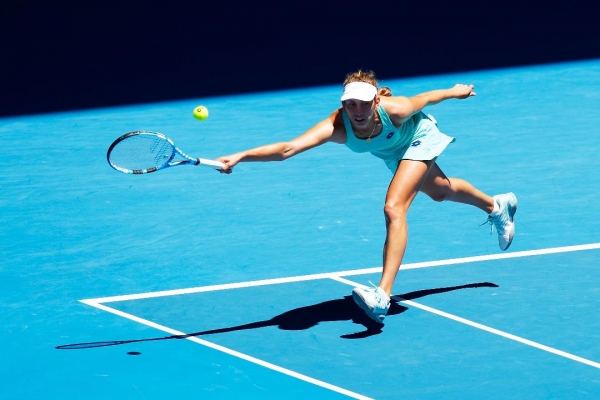Adversity arrived early for Elise Mertens.
The 22-year-old Belgian, ranked 37th in the world, faced break point in her opening service game against No.4 seed Elina Svitolina at Rod Laver Arena on Tuesday afternoon.
Match report: Mertens stuns Svitolina
Moment of truth time.
To the ad court, the first serve missed down the centre. The second serve toss was way too far in front, and she let it bounce. The second serve went in to Svitolina’s forehand, and it was returned long.
You can’t miss second serve returns. Never, ever on break point.
Mertens held serve a handful of points later, and would break Svitolina to love in the following game. That dynamic plays out at every level of our sport.
For the returner, the excitement of manufacturing break point is quickly replaced with the disappointment of not converting it. For the server, the anxiety of facing break point is replaced with the exhilaration of holding, and that positive wave of energy facilitates the immediate break in the next game.
You can see it coming a thousand mile away.
Mertens was empowered by the hold and cracked four winners against Svitolina in the following game. At 0-30, Svitolina hit a 150 km/h first serve to Mertens’ forehand return. The Belgian stepped inside the baseline and cracked a 122 km/h return winner cross court. At 0-40, Mertens laced a backhand return that Svitolina barely touched.
A couple of minutes earlier, Mertens was in a very precarious position. Now she was running away with the match. Hello, momentum.
Mertens did everything well in this match, and brings a rampaging all-round game into the Australian Open semifinals.
Her serve was outstanding against Svitolina. She was broken only once, and won an impressive 11 of 17 of her second serve points, including all five she hit in the second set.
Mertens dominated from the baseline against a very solid baseliner in Svitolina. Mertens had averaged winning 51 per cent (176/346) of her baseline points coming into the quarterfinal, but that skyrocketed to 58 per cent (32/55) against Svitolina. Who saw that coming?
Mertens has a very solid forehand that can push opponents around all over the court, but her backhand is probably better. She hit four forehand winners and 13 backhand winners in this match.
There are no holes in her game from the back of the court, and she feels very comfortable coming forward to finish off points at the net as well. Mertens came to the net the most of any of her five matches so far this year in Melbourne, winning 75 per cent (15/20). She has now won 74 per cent (54/73) at net for the tournament. The tournament average is 67 per cent.
Labelling Mertens as an aggressive baseliner would not be doing her justice. She is an all-court attacker, equally adept at dissecting an opponent from the back and the front of the court. Her playing style is an ideal model for a young player looking to play under the bright lights.
Mertens will play either Caroline Wozniacki or Carla Suarez Navarro in Thursday’s semifinal. There is no reason that Mertens can’t get through that one as well.
This Belgian has legitimate aspirations for silverware.
